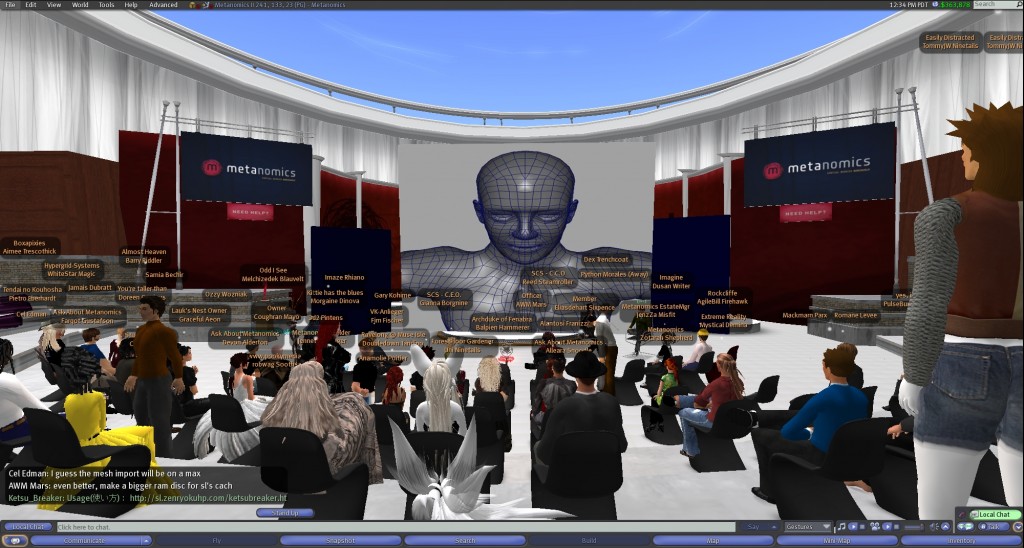
The barrier of entry just keeps getting lower for for architects, engineers and construction professionals to further employ MMO (massively, multi-player, online) environments in design collaboration, education, visualization and architectural discourse. Here are a few bits and pieces of the puzzle that I’m keeping an eye on.
First off, Linden Lab announced (and demonstrated) at SLCC convention earlier this year that they are currently working toward supporting 3D model imports into Second Life. They didn’t give any indication as to when this might happen (or, technically even if-this is really going to happen), but they did acknowledge that it is on their radar, and that they’re actively working on something. This would theoretically make it possible for AEC professionals to import the 3D assets they work with as a matter of daily practice into a realtime, online virtual environment.
This could be a huge opportunity, perhaps even in combination with their new ‘SLE’ or Second Life Enterprise offering, to bring in full-scale architectural models – making the experience of a design prototype much more tangible and holistic. Enabling project stakeholders and members of the community to walk through a virtual prototype of a building at their own pace, alongside others – discussing the design inside of this rich, realtime, 3D environment is so much closer to the way we actually experience design in the real world – at least moreso than an artist’s interpretation, or speedy fly-through animation, in my opinion.
The opportunity is clear, but I think the challenges ahead of this offering are many. The social-political nature of Second Life requires Linden Lab to be very patient and cautious with a feature like this – one that has the potential to upset their existing economy and further challenge the IP issues they obviously need to take very seriously.
As for OpenSim (the platform upon which the Architecture Islands grid is built), I have heard a resounding ‘YES!’ when I ask around about if OpenSim will ever see 3D model imports – but, much like Linden Lab none of the developers or stakeholders close to the project can estimate when this might happen. The best hope here might still be realxtend, and its new BSD-licensed open source viewer that I’m told might help solve some issues and roadblocks facing realxtend itself – and potentially OpenSim in general.
While we await advances within these larger ‘virtual worlds’ communities, its definitely worth keeping an eye on recent news from the game development world – namely Unreal and Unity3D (aka ‘Unity’ – covered extensively on Digital Urban). After Unity announced that it will be giving away its ‘Indie’ development package for free, Unreal announced the launch of its UDK (Unreal Development Kit) – also free.
Each platform has its own merits, and potential benefits to professional AEC applications. Unfortunately, I haven’t been able to figure out how to import models into UDK yet (though I’m told it isn’t that difficult, I still can’t figure it out..) – I took about 20 minutes to figure out how to import relatively large architectural models from Autodesk Revit 2009 into Unity. It’s almost scary how well this application works – enabling users to quickly build their levels into stand-alone applications (.exe files) compatible with both Mac and PC – or to export it as a web builds that can be embedded on a website. You could even export the model to an iPhone or Nintendo Wii game.
Developers have already created incredibly sophisticated online MMO’s with Unity – namely FusionFall, for the Cartoon Network. I don’t imagine it will be long before other virtual worlds and serious games start to take hold in this new wave of indie-worlds. Just look at what this company has been able to do with Unity (be sure to click the exterior on and off). There are quite a few examples within the Unity forum of people using Unity for architectural visualization of all kinds. Once I got the hang of it, I was able to drag a model from Revit, add some lights, embed the model on my website and forward the link to a client to explore it – all in under 1 hour. If I change the model in Revit and click back into Unity – the changes I make are updated automatically, textures, lights and other components still in tact. If I push that update back out to the web, my client can hit ‘refresh’ and see the change – all inside of a few minutes. That’s some seriously powerful stuff. Plus, I could make the project into an iPhone app, or Nintendo Wii game if I really wanted to – imagine that!
Yet, without the ‘world’ or framework of a larger social network to collaborate and explore with, these platforms aren’t much more than advanced visualization tools from an AEC perspective. But I’m confident all of that will be changing very soon, and I think exploring these new platforms is a worthwhile endeavor because it gives us a glimpse of what the future could be like in the very near future as all of these vectors begin to merge. I’m sure there are lots of virtual worlds in development on platforms like Unity, just as I’m sure there are lots of programmers working on model imports and light-weight clients that will invariably find their way to virtual worlds. In the meantime, the software giants will start bringing social elements and realtime visualization into CAD and BIM.
So, don’t turn in your plasma blaster for a virtual t-square just yet – but be ready! It don’t think we will have to wait much longer.

